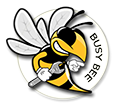I hope you don't mind - I copied the image from Imgur ... for some odd reason I couldn't even load it without doing some extra effort.
So I'd start with making a bill of materials needed:
- Load cell (I just learned that this converts weight/pressure to some readable, like this item)
- a HX711 module (like this one)
- I see two push buttons (default open, closes when pushing the button)
- 2x 10 KOhm resistors
- Arduino Uno
- A piezo buzzer
- a 16x2 LCD screen with I2C connections
I think the confusing part may be the display section. The "I2C" and the "LCD" can be bought as one single item, or as two items: a LCD screen and a I2C module.
More details can be found here: Arduino LCD I2C tutorial.
The load cell has 4 wires, and they go to the HX711 module:
LOAD CELL HX711
-----------------------
Green (Sig +) -> A+
White (Sig -) -> A-
Black (Exc -) -> E-
Red (Exc +) -> E+
The HC711 module has 4 more pins to connect:
VCC -> +5 Volt
GND -> Ground (or minus)
CLK (or Clock) -> Arduino Pin 2
DT (or Data) -> Arduino Pin 3
The Arduino is has a push button and a resistor on the pins A0 and A1.
The buzzer goed on Pin 13 of the Arduino.
The I2C of the LCD is connected to Arduino Pin A4 (I2C pin: SDA) and Arduino A5 (I2C pin: SEL) of the Arduino.
Note: The Arduino will also need +5V and GND connected (the schematic is not showing this, which is not uncommon).
The LCD display needs +5V and GND as well of course.
Since this all is pretty obvious to me, tell me where you're getting stuck and I'll try to explain ... 😊

